R. C. Searle – Research
Most of my research concerns geophysical studies of the tectonic and magmatic processes occurring at mid-ocean ridges. The main themes are:
- Oceanic microplates
- The slow spreading Mid-Atlantic Ridge
- Ridge-hotspot interaction (Reykjanes Ridge/Iceland mantle plume)
- The very slow spreading South West Indian Ridge
- The Mid-Cayman Spreading Centre
- Oceanic Core Complexes and detachment faults
Oceanic microplates
Mid-ocean ridge microplates are small tectonic plates just a few hundred kilometres across, where two spreading centres overlap each other. We have studied two in detail: the Easter microplate (East Pacific Rise 25°S) and Juan Fernandez microplate (East Pacific Rise 33°S). Comprehensive sonar imaging combined with detailed studies of magnetic anomalies showed that both microplates originated about 5 million years ago, and grew rapidly by propagation of their spreading centres while rotating rigidly at rates of around 15° per million years, rather like ball bearings trapped between the major plates.
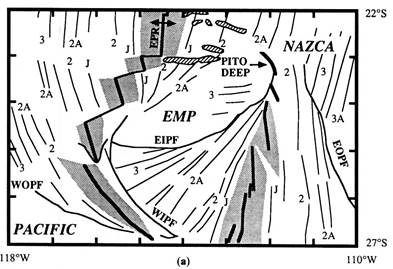
Selected publications
Searle, R.C., R.I. Rusby, J. Engeln, J. Zukin, P.M. Hunter, T.P. Lebas, H.-J. Hoffman, and R. Livermore, Comprehensive sonar imaging of the Easter microplate, Nature, 341, 701-705, 1989.
Larson, R.L., R.C. Searle, M.C. Kleinrock, H. Schouten, R.T. Bird, D.F. Naar, R.I. Rusby, E.E. Hooft, and H. Lasthiotakis, Roller-bearing tectonic evolution of the Juan Fernandez microplate, Nature, 356, 571-576, 1992.
Rusby, R.I., and R.C. Searle, Intraplate thrusting near the Easter Microplate, Geology, 21, 311-314, 1993.
Searle, R.C., R.T. Bird, R.I. Rusby, and D.F. Naar, The development of two oceanic microplates: Easter and Juan Fernandez microplates, East Pacific Rise, Journal of the Geological Society of London, 150, 965-976, 1993. Abstract
Rusby, R.I., and R.C. Searle, A history of the Easter Microplate, 5.25 Ma to Present, Journal of Geophysical Research, 100 (B7), 12,617-12,640, 1995. Abstract
Bird, R.T., D.F. Naar, R.L. Larson, R.C. Searle, and C.R. Scotese, Plate tectonic reconstructions of the Juan Fernandez microplate: Transformation from internal shear to rigid rotation., Journal of Geophysical Research, 103 (B4), 7049-7067, 1998. Abstract
Neves, M.C., R.C. Searle, and M.H.P. Bott, Easter microplate dynamics, Journal of Geophysical Research, 108 (B4), ETG14, doi:10.1029/2001JB000908, citation no. 2213, 2003.
Neves, M., M.H.P. Bott, and R.C. Searle, Patterns of stress at midocean ridges and their offsets due to seafloor subsidence, Tectonophysics, 386, 223-242, 2004.
Searle, R.C., J. Francheteau, and R. Armijo, Compressional ridges in young oceanic lithosphere near the Easter microplate: A seafloor gravity and manned submersible investigation, Geophysical Journal International, in press, 2006.
The slow spreading Mid-Atlantic Ridge
MAR 29°N – Quantifying tectonic strain at mid-ocean ridges
We carried out a very detailed study of a single mid-ocean ridge spreading segment at 29°N on the Mid-Atlantic Ridge (Searle et al., 1998; Escartin et al., 1999; Allerton et al., 2000). The image below shows the seafloor topography in shaded relief (cool colours are deeper). The coordinates are UTM metres. The image reveals the almost N-S trending median valley in the centre, at right angles to the WNW-ESE spreading direction. It is offset dextrally by about 15 km via a non-transform offset (purple basins) in the south. The northern offset is also dextral, just seen at the top of the image. An axial volcanic ridge runs along the centre of the median valley and marks the plate boundary and locus of new lithospheric accretion. Fault scarps are clearly seen parallel to the median valley: our study showed that movement on these faults accounts for about 10% of the total crustal extension, the rest being provided by intrusion of magma at the spreading axis.

The following image is an approximately 16 x 30 km TOBI (Towed Ocean Bottom Instrument) deep-towed sidescan sonar image of part of the 29°N study area. North is the top; insonification direction to the bottom (south). Light tones indicate high backscattering. The left side of the image shows the axial volcanic ridge on zero-age crust, composed of piles of small and larger volcanic cones. Note the cratered volcano at the top edge of the image. The narrow, linear, bright features in the rest of the image are fault scarps. Uniform grey areas are sediment ponds, accumulating as the seafloor ages. The sonar data has a horizontal resolution of about 10 m and reveals strongly varying seafloor textures that allow us to clearly identify different volcanic, tectonic and sedimentary landforms, and track their development.
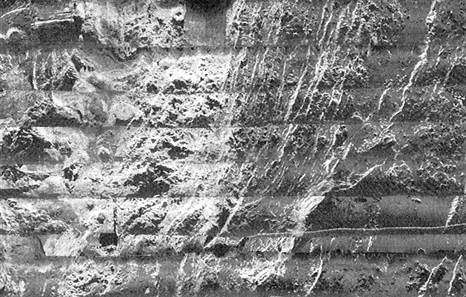
Selected publications
Searle, R.C., et al., Fault structure and detailed evolution of a slow spreading ridge segment: the Mid-Atlantic Ridge at 29°N, Earth and Planetary Science Letters, 154 (1-4), 167-183, 1998. Abstract
Escartin, J., et al., Quantifying tectonic strain and magmatic accretion at a slow-spreading ridge segment, Mid-Atlantic Ridge, 29°N, Journal of Geophysical Research, B, 104, 10,421-10,437, 1999.
Allerton, S., J. Escartin, and R.C. Searle, Extremely asymmetric magmatic accretion of oceanic crust at the ends of slow-spreading ridge-segments, Geology, 28, 179-182, 2000.
Axial Volcanic Ridges
We first mapped extensive axial volcanic ridges on the Reykjanes Ridge using GLORIA in 1977. In 1990 a TOBI survey revealed the volcanic nature of these ridges and enabled us to suggest a life-cycle for them.
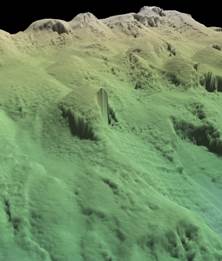
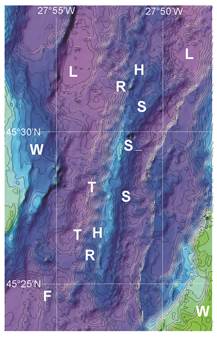
In May-June 2008 we made a detailed study of the axial volcanic ridge on the Mid-Atlantic Ridge at 45°N (right – letters identify different volcanic landforms). The prime objectives were 1) to date the evolution of such ridges (which are near-ubiquitous and integral to the creation of oceanic crust), and 2) to determine their volcanic stratigraphy, architecture and melt sources. We carried out comprehensive imaging at a variety of nested scales to map detailed volcanic structures such as cones, ridges and lava flows, and took over 270 precisely-located samples from them using an ROV. We found that the AVR is probably only about 12 ka old, compared to the 180 ka age predicted for a uniform spreading rate 0f 20 km Ma-1. We found that the AVR surface comprises some 3000 individual volcanic ‘hummocks’, whose dimensions were determined for the first time. They have profiles ranging from low domes to pointed cones, and their diameters range from a few tens of metres to ~500m. The height to diameter ratio ranges from 1:10 (characteristic of larger volcanic seamounts) to about 1:5. A large proportion of these hummocks suffer partial collapse under gravity shortly after their formation (below, left).
Left: high resolution image of part of the flank of the axial volcanic ridge at 45°N showing (centre) a volcanic hummock some 100 m high with a collapsed flank. No vertical exaggeration.
Selected publications
Laughton, A. S., R. C. Searle, and D. G. Roberts (1979), The Reykjanes Ridge crest and the transition between its rifted and non-rifted regions, Tectonophysics, 55, 173-177.
Parson, L. M., B. J. Murton, R. C. Searle, D. Booth, J. Evans, P. Field, J. Keeton, A. Laughton, E. McAllister, N. Millard, L. Redbourne, I. Rouse, A. Shor, D. Smith, S. Spencer, C. Summerhayes, and C. Walker (1993), En echelon volcanic ridges at the Reykjanes Ridge: a life cycle of volcanism and tectonics, Earth and Planetary Science Letters, 117, 73-87.
Searle, R. C., B. J. Murton, K. Achenbach, T. LeBas, M. Tivey, I. Yeo, M. Cormier, J. Carlut, P. Ferreira, C. Mallows, K. Morris, N. Shroth, P. v. Calsteren, and C. Waters (2010), Structure and development of an Axial Volcanic Ridge: Mid-Atlantic Ridge, 45°N, Earth and Planetary Science Letters, 299, 228-241.
Yeo, I., R. C. Searle, K. Achenbach, T. LeBas, and B. J. Murton (2012), Eruptive hummocks: building blocks of the upper ocean crust, Geology, 40(1), 91-94.
The Reykjanes Ridge
The Reykjanes Ridge is part of the Mid-Atlantic Ridge or North-America/Eurasia plate boundary and extends southwestward from Iceland. The spreading direction is almost EW, so the overall ridge trend is highly oblique. It is also unusual for a slow spreading ridge in having no median valley over much of its length. We believe these features reflect the influence of the nearby Iceland mantle plume which makes the mantle slightly hotter than normal over the Mid-Atlantic Ridge and so modifies the way the lithosphere responds to spreading. This image shows the ridge topography over about a 60 km square at 60°30’N. Warm colours are shallow. Here the axial volcanic ridge is split into a series of en echelon (overlapping) volcanic ridges running SW to NE across the centre of the image. Each individual ridge is nearly perpendicular to the spreading direction, but the overall trend is not. Most of the topography seen here is volcanic in origin; there is relatively little faulting (another effect of the plume). Our studies of the magnetic field over the Reykjanes Ridge have enabled us to infer variations in the magnetisation of the crust, which can be related to variations in the chemical composition, thickness and age of the lavas.

Selected publications
Lee, S.-M., and R.C. Searle, Crustal magnetization of the Reykjanes Ridge and implications for its along-axis variability and the formation of axial volcanic ridges, Journal of Geophysical Research, 105, 5907-5930, 2000.
Searle, R.C., et al., The Reykjanes Ridge: structure and tectonics of a hot-spot influenced, slow-spreading ridge, from multibeam bathymetric, gravity and magnetic investigations, Earth and Planetary Science Letters, 160, 463-478, 1998. Abstract
The very slow spreading South West Indian Ridge
Recent work has concentrated on the very-slow spreading (7 km Ma-1 half-rate) Southwest Indian Ridge, and has been designed to test the hypothesis that at very slow spreading rates the detailed processes at work are different from those seen at the faster-spreading Mid-Atlantic Ridge. Preliminary results show a gross asymmetry in crustal thickness across the ridge axis, even though the long-term spreading rate is reasonably symmetric and constant. However, short-term (< 2 Ma) asymmetric accretion is occurring by such processes as detachment faulting on one flank accompanied by slow magmatic accretion on the opposite one. At least one major oceanic core complex and detachment fault system (FUJI Dome – below) has been found here.
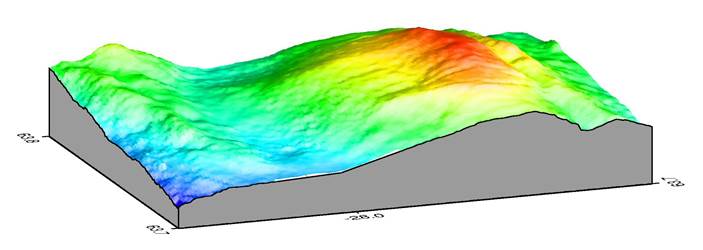

In 2010 I was invited to join the French ‘Smooth Seafloor’ cruise on the Marion DuFresne to investigate the smooth seafloor on the eastern end of the Southwest Indian Ridge.This used TOBI and dredging to characterise the smooth ridges that had been found by bathymetric surveying. The 2010 studies revealed a new form of seafloor spreading, in which detachment faults of alternating polarity exhume mantle directly onto the seafloor, with very little volcanism.
Selected publications
Searle, R.C., M. Cannat, K. Fujioka, C. Mevel, H. Fujimoto, A. Bralee, and L. Parson, The FUJI Dome: A large detachment fault near 64°E on the very slow-spreading southwest Indian Ridge, Geochemistry, Geophysics, Geosystems, 4 (8), 9105, doi:10.1029/2003GC000519, 2003.
Searle, R.C., and A.V. Bralee, Asymmetric generation of oceanic crust at the ultra slow spreading Southwest Indian Ridge, 64ºE, Geochemistry, Geophysics, Geosystems, 8, (5), doi:10.1029/2006GC001529, 2007.
Sauter, D., M. Cannat, S. Rouméjon, M. Andreani, D. Birot, A. Bronner, D. Brunelli, J. Carlut, A. Delacour, V. Guyader, C. MacLeod, G. Manatschal, V. Mendel, B. Ménez, V. Pasini, E. Ruellan, and R. Searle (2013), Continuous exhumation of mantle-derived rocks at the Southwest Indian Ridge for 11 Myr, Nature Geoscience, DOI: 10.1038/NGEO1771.
The Mid-Cayman Spreading Centre

The Mid-Cayman Spreading Centre is a short ridge axis sandwiched between two slow-slipping transform faults, which results in its being the deepest known spreading centre. I joined a cruise led by Southampton Oceanography Centre in 2010 which carried out detailed surveying, including detection of the world’s deepest known hydrothermal vents. The 100-km-long spreading segment (left) contains a wide variety of crustal accretion mechanisms: ‘normal’ volcanic accretion producing an axial volcanic ridge; mantle exhumation via detachment faults producing one or more oceanic core complexes; probably direct exhumation producing ‘smooth’ sea floor, and extensive off-axis volcanism (below). Preliminary results of the geological work were presented at the 2012 AGU Fall Meeting in papers OS11E-06 and OS13B-1733.

Left: bathymetry of the Mid-Cayman Spreading Centre.
Right: TOBI sidescan image draped over bathymetry (with 100 m contours), showing extensive lava flows on the marginal floor of the axial valley. Image width ~ 20 km; neovolcanic zone at bottom left; margin of axial valley at top of image.
Selected publications
Connelly, D., J. Copley, B. Murton, K. Stansfield, P. Tyler, C. German, C. Van Dover, D. Amon, M. Furlong, N. Grindlay, N. Hayman, V. Huhnerbach, M. Judge, T. Le Bas, S. McPhail, A. Meier, K. Nakamura, V. Nye, M. Pebody, R. Pedersen, S. Plouviez, C. Sands, R. Searle, P. Stevenson, S. Taws, and S. Wilcox (2012), Hydrothermal vent fields and chemosynthetic biota on the world’s deepest seafloor spreading centre, Nature Communications, 3(Article 620).
Oceanic Core Complexes and detachment faults
Atlantis Massif Oceanic Core Complex
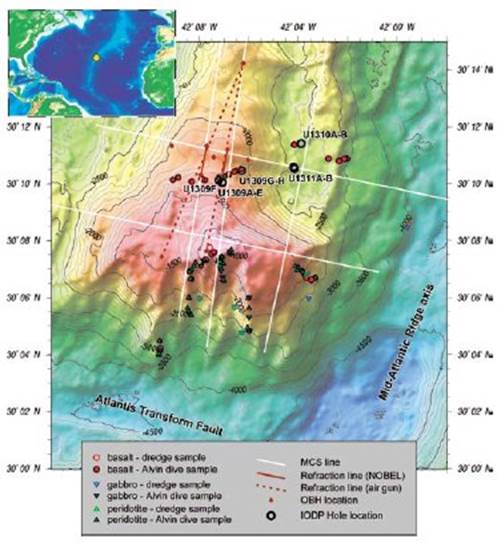
I participated in IODP expedition 304 which drilled the Atlantis Massif OCC in the central Atlantic in 2004. This showed the core complex, at least in part, to be underlain by extensive gabbro rather than the expected peridotite. I acted as Physical Properties Specialist, and worked particularly on the magnetic properties of the cores.
Selected publications
Beard, J. S., B. R. Frost, P. Fryer, A. McCaig, R. Searle, B. Ildefonse, P. Zinin, and S. K. Sharma (2009), Onset and Progression of Serpentinization and Magnetite Formation in Olivine-rich Troctolite from IODP Hole U1309D, Journal of Petrology, 50(3), 387-403.
Blackman, D. K., G. D. Karner, and R. C. Searle (2008), Three-Dimensional Structure of Oceanic Core Complexes: Effects on Gravity Signature and Ridge Flank Morphology, Mid-Atlantic Ridge 30°N, Geochemistry, Geophysics, Geosystems, 9(6), Q06007, doi:06010.01029/02008GC001951.
Blackman, D. K., B. Ildefonse, B. E. John, Y. Ohara, D. J. Miller, M. A. IODP 304-305 Science Party N. Abe, E.S. Andal, M. Andreani, S. Awaji, J.S. Beard, D., A. B. C. Brunelli, D.M. Christie, J. Collins, A.G. Delacour, H. Delius, M. Drouin, F., J. E. Einaudi, B.R. Frost, G. Früh-Green, P.B. Fryer, J.S. Gee, M. Godard, C.B., A. H. Grimes, H-E. Hansen, A.C. Harris, A. Tamura, N.W. Hayman, E. Hellebrand,, J. G. H. T. Hirose, S. Ishimaru, K.T.M. Johnson, G.D. Karner, M. Linek, C.J. MacLeod,, O. U. M. J. Maeda, A.M. McCaig, K. Michibayashi, A. Morris, T. Nakagawa, T., M. R. Nozaka, R.C. Searle, G. Suhr, M. Tominaga, A. von der Handt, T. Yamasaki, X., and Zhao (2011), Drilling constraints on lithospheric accretion and evolution at Atlantis Massif, Mid-Atlantic Ridge 30°N, Journal of Geophysical Research, 116, Article Number: B07103.
Morris, A., J. S. Gee, N. Pressling, B. E. John, C. J. MacLeod, C. B. Grimes, and R. C. Searle (2009), Footwall rotation in an oceanic core complex quantified using reoriented Integrated Ocean Drilling Program core samples, Earth and Planetary Science Letters, 28, 217-228.
MAR 13°N: Origin, structure and deformation of the oceanic lithosphere in an area of poorly-magmatic crust
A project started in 2007 to examine the origin, structure and deformation of the oceanic lithosphere in an area of poorly-magmatic crust on the Mid-Atlantic Ridge around 13ºN. We went to sea on the first scientific cruise of the UK’s new research vessel James Cook in March 2007. Preliminary results were presented at the American Geophysical Union Fall Meeting, December 2007, in contributions T51F-01, and T53B-1307 – T53B-1309 and T53B-1311. Subsequent work revealed a spectacular image of an active oceanic detachment fault, and led to a new model for the development and life-cycles of oceanic core complexes.
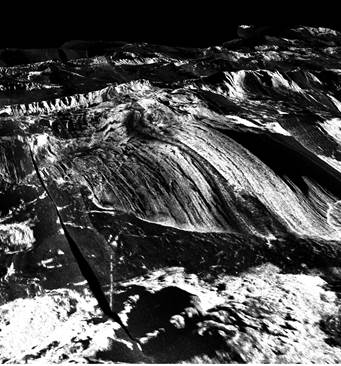

Above: Bathymetry of part of the median valley in the study area looking NE, showing (centre) a prominent, active oceanic core complex.
Right: sonar image of the same OCC draped over bathymetry, looking NW across the axial neovolcanic zone. OCC is ~10 km in E-W extent.
Selected publications
MacLeod, C. J., R. C. Searle, B. J. Murton, J. F. Casey, C. Mallows, S. C. Unsworth, K. Achenbach, and M. Harris (2009), Life cycle and internal structure of oceanic core complexes, Earth and Planetary Science Letters, 287(3-4), 333-344.
Mallows, C., and R. C. Searle (2012), A geophysical study of oceanic core complexes and surrounding terrain, Mid-Atlantic Ridge at 13°-14°N, Geochemistry Geophysics Geosystems, 13, Q0AG08.
MAR 13°N revisited
We have a new project funded to revisit the MAR 13°N area on RRS James Cook cruise 132, sailing January 2016. The aim is to use seismic methods (wide-angle refraction and tomography and seismic reflection) to image the geometry of the detachment faults sub-seabed, and in particular to test whether and how they are linked along and across flow lines. In addition we will use the AUV Autosub 6000 to map the near-seabed magnetic field and topography in great detail. The magnetic data are intended to determine variations in the degree of asymmetric spreading along the ridge axis, while the topographic measurements will aid a detailed structural analysis of the faulting mechanisms.
Teacher at sea
A particular feature of our new project will be incorporating a secondary school teacher in the sea-going team. We aim to recruit someone to join us in the research expedition, to assist with our associated outreach to schools, and to use the experience to enrich their own teaching. Further details are available here.
